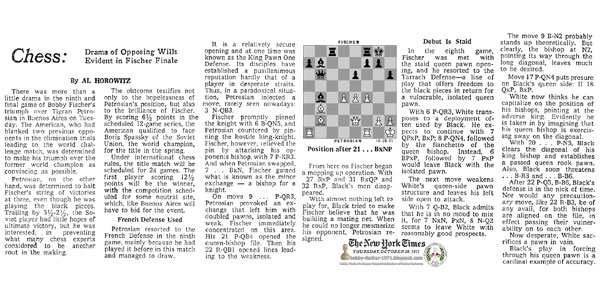New York Times, New York, New York, Thursday, October 28, 1971 - Page 37
Chess: Drama of Opposing Wills Evident in Fischer Finale by Al Horowitz
There was more than a little drama in the ninth and final game of Bobby Fischer's triumph over Tigran Petrosian in Buenos Aires on Tuesday. The American, who had blanked two previous opponents in the elimination trials leading to the world challenge match, was determined to make his triumph over the former world champion as convincing as possible.
Petrosian, on the other hand, was determined to halt Fischer's string of victories at three, even though he was playing the black pieces. Trailing by 5½-2½, the Soviet player had little hopes of ultimate victory, but he was interested in preventing what many chess experts considered to be another rout in the making.
The outcome testifies not only to the hopelessness of Petrosian's position, but also to the brilliance of Fischer. By scoring 6½ points in the scheduled 12-game series, the American qualified to face Boris Spassky of the Soviet Union, the world champion for the title in the spring.
Under international chess rules, the title match will be scheduled for 24 games. The first player scoring 12½ points will be the winner, with the competition scheduled for some neutral site, which, like Buenos Aires will have to bid for the event.
French Defense Used
Petrosian resorted to the French Defense in the ninth game, mainly because he had played it before in this match and managed to draw.
It is a relatively secure opening and at one time was known as the King Pawn One Defense. Its disciples have established a pusillanimous reputation hardly that of a player in desperate straits. Thus, in a paradoxical situation, Petrosian injected a move, rarely seen nowadays: 3. N-QB3.
Fischer promptly pinned the knight with 6. B-QN5, and Petrosian countered by pinning the hostile king-knight. Fischer, however, relieved the pin by attacking his opponent's bishop, with 7. P-KR3. And when Petrosian swapped, 7. … BxN, Fischer gained what is known as the minor exchange — a bishop for a knight.
On move 9. … P-QR3, Petrosian provoked an exchange that left him with doubled pawns, isolated and weak. Fischer immediately concentrated on this area. His 21. P-QB4 opened the queen-bishop file. Then his 22. R-QB1 opened lines leading to the weakness.
From here on Fischer began a mopping up operation. With 27. RxP and 31. RxQP and 32. RxP, Black's men disappeared.
With almost nothing left to play for, Black tried to make Fischer believe that he was building a mating net. When he could no longer mesmerize his opponent, Petrosian resigned.
Debut Is Staid
In the eighth game, Fischer was met with the staid queen pawn opening, and he resorted to the Tarrasch Defense—a line of play that offers freedom to the black pieces in return for a vulnerable, isolated queen pawn.
With 6. P-QR3, White transposes to a deployment often used by Black. He expects to continue with 7. QPxP, BxP; 8. P-QN4, followed by the fianchetto of the queen bishop. Instead, 6. BPxP, followed by 7. PxP would leave Black with the isolated pawn.
The next move weakens White's queen-side pawn structure and leaves his left side open to attack.
With 7. Q-B2, Black admits that he is in no mood to mix it, for 7. NxN, PxN, 8. N-Q2 seems to leave White with reasonably good prospects.
The move 9. B-N2 probably stands up theoretically. But clearly, the bishop at N2, pointing its way through the long diagonal, leaves much to be desired.
Move 17. P-QN4 puts pressure on Black's queen side: If 18. QxP, BxP.
White now thinks he can capitalize on the position of his bishops, pointing at the adverse king. Evidently he is taken in by imagining that his queen bishop is exercising sway on the diagonal.
With 20. … P-N5, Black clears the diagonal of his king bishop and establishes a passed queen rook pawn. Also, Black soon threatens … B-R3 and … B-B6.
After 22. P-Q5, B-B6, Black's defense is in the nick of time. Nor would any precautionary move, like 22. R-B3, be of any avail, for both bishops are aligned on the file, in effect passing their vulnerability on to each other.
Now desperate, White sacrifices a pawn in vain.
Black's play in forcing through his queen pawn is a cardinal example of accuracy.
Tigran Vartanovich Petrosian vs Robert James Fischer Fischer - Petrosian Candidates Final (1971), Buenos Aires ARG, rd 8, Oct-23 Tarrasch Defense: Symmetrical Variation (D32) 0-1 https://www.chessgames.com/perl/chessgame?gid=1044717























